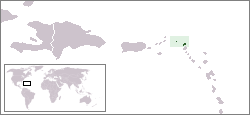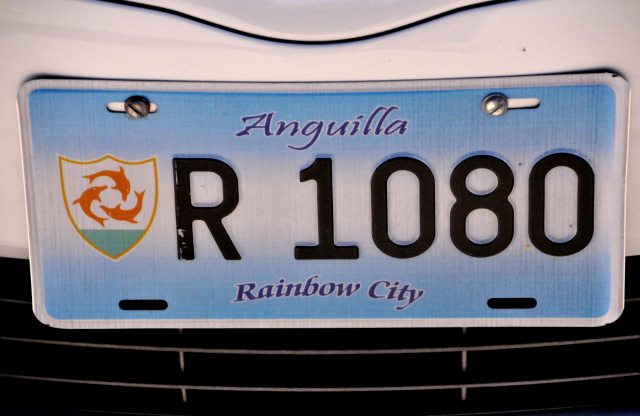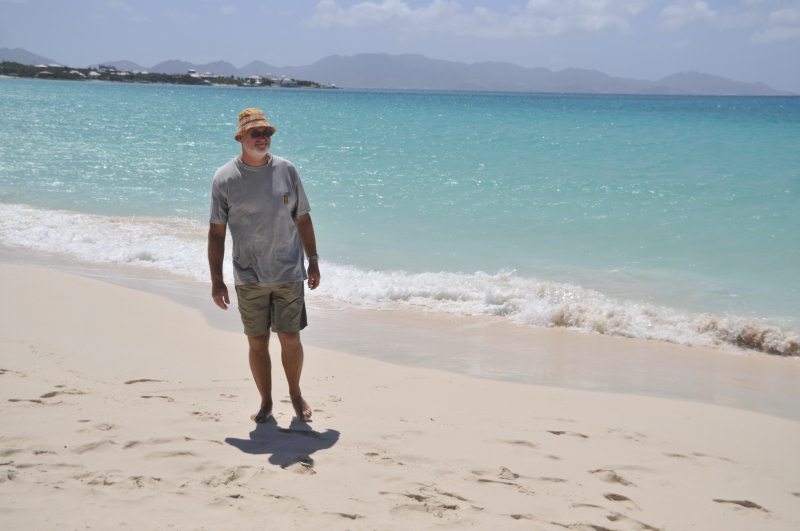Anguilla

|
Anguilla
 Anguilla is a British overseas territory in the
Caribbean, one of the most northerly of
the Leeward
Islands in the Lesser
Antilles. It consists of the main island of
Anguilla itself, approximately 16 miles long by 3.1 miles wide at its widest
point, together with a number of much smaller islands and cays with no permanent population. The
island's capital is The Valley. The total land area of the
territory is thirty five square miles, with a population of approximately 13,500
(2006 estimate). History Anguilla was first settled by Amerindian tribes who migrated from
South
America. The earliest Amerindian artifacts found
on Anguilla have been dated to around 1300 BC, and remains of settlements date
from 600 AD. These early inhabitants called the island Malliouhana. The date of
European discovery is uncertain: some sources claim that Columbus sighted the island in 1493, while
others state that the island was first discovered by the French in 1564 or 1565.
The name Anguilla derives from the word for "eel" in any of various Romance
languages, probably chosen because of the
island's eel-like shape. Anguilla was first colonised by English settlers from Saint
Kitts, beginning in 1650. The French temporarily
overtook the island in 1666 but under the Treaty of Breda it was returned to English
control. Other early arrivals included Europeans from Antigua and Barbados. It is likely that some of these
early Europeans brought enslaved Africans with them. Historians confirm
that African slaves lived in the region in the
early seventeenth century. Africans from Senegal lived in St. Christopher (today
St. Kitts) in 1626. By 1672 a slave depot existed on the island of Nevis,
serving the Leeward Islands. While the time of African
arrival in Anguilla is difficult to place precisely, archive evidence indicates
a substantial African presence - at least 100 on the island by
1683. The island was administered by England, later the United Kingdom, until the early nineteenth century when – against the wishes of the inhabitants – it was incorporated into a single British dependency along with Saint Kitts and Nevis. After two rebellions in 1967 and 1969 and a brief period as a self-declared independent republic headed by Ronald Webster, British rule was fully restored in July 1971. Anguilla became a separate British dependency (now termed a British overseas territory) in 1980.

Politics Anguilla is an internally self-governing overseas territory of the United
Kingdom. Its politics takes place in a framework
of a parliamentary representative democratic dependency, whereby the Chief Minister is the head of
government, and of a pluriform multi-party
system. The
United Nations Committee on Decolonisation
includes Anguilla on the United Nations list of Non-Self-Governing
Territories. The territory's constitution is
Anguilla Constitutional Order 1st of April 1982 (amended 1990).
Executive power is exercised by the
government. Legislative power is vested in both the
government and the House of Assembly. The Judiciary is independent of the executive
and the legislature. Military As a dependency of the United Kingdom, the UK is responsible for its military defence, although there are no active garrison or armed forces present. The Royal Navy came to give aid the last time the island was hit and damaged by a hurricane in 1995.
 Geography Anguilla is a flat, low-lying island of coral and limestone in the
Caribbean
Sea, east of Puerto Rico. The soil is generally thin
and poor, supporting only scrub vegetation. Anguilla is noted for its spectacular and ecologically important
coral
reefs. Apart from the main island of Anguilla
itself, the territory includes a number of other smaller islands and cays,
mostly tiny and uninhabited. Some of these are: ·
Sombrero, also known as Hat
Island
Climate Anguilla has a tropical though rather dry climate, moderated by northeast
trade winds. Temperatures vary little
throughout the year. Average daily maximum range from about 27 °C in December to
30 °C in July. Rainfall is erratic averaging about 35 inches per year, the
wettest months being September and October, and the driest February and March.
Anguilla is vulnerable to hurricanes from June to November, peak season August
to mid-October. Economy Anguilla's thin arid soil is largely unsuitable for agriculture, and the
island has few land-based natural
resources. Its main industries are tourism,
offshore
incorporation and management, offshore
banking and fishing. Many insurance and financial
business are headquartered in Anguilla. The economy is expanding rapidly, especially the tourism sector which is driving major new developments in partnerships with multi-national companies. This boom, beginning gently during 2005-2006, accelerating through 2007 and is expected to continue for years. Currency Anguilla's currency is the East Caribbean dollar, though the US dollar is also widely accepted. Transportation Anguilla is served by Wallblake Airport. Services connect to
various other Caribbean islands, but the airport cannot receive large jets and
there are no direct flights to or from continental America or Europe. Regular
ferries link Anguilla and the neighbouring island of Saint
Martin, with a journey time of about twenty
minutes. Aside from taxis, there is no public transport on the island. Cars drive
on the left but like many of the islands we have visited most of the cars are
imported from America, so the steering wheel is on the left, which upset Bear as
it was my turn to drive and he hated cars coming at me
in the middle.

Demographics The
majority of residents (90.08%) are black, the descendants of slaves transported
from Africa. Growing minorities include whites at 3.74% and people of mixed race
at 4.65% (figures from 2001 census). 72%
of the population is Anguillian while 28% is non-Anguillian (2001 census). Of
the non-Anguillian population, many are citizens of the US, UK, St Kitts &
Nevis, the Dominican Republic, Jamaica and Nigeria. 2006 and 2007 saw an influx of large numbers of Chinese, Indian and
Mexican workers, brought in as labour for major tourist developments due to the
local population not being large enough to support the labour
requirements. Culture The
Anguilla National Trust (ANT) was
established in 1988 and opened its offices in 1993 charged with the
responsibility of preserving the heritage of the island, including its cultural
heritage. The Trust has programmes encouraging Anguillian writers and the
preservation of the island's history. The
island's cultural history begins with the Taino Indians. Artifacts have been found
around the island, telling of life before European settlers
arrived. As
throughout the Caribbean, holidays are a cultural
fixture. Anguilla's most important holidays are of historic as much as cultural
importance – particularly the anniversary of the emancipation (previously August
Monday in the Park), celebrated as the Summer Festival. British holidays, such as the Queen's
birthday, are also celebrated. Religion According to the 2001 census Christianity is Anguilla's predominant religion, with 29 percent of the population practicing Anglicanism. Another 23.9 percent are Methodist. Other churches on the island include Seventh-day Adventist, Baptist, Roman Catholic and Jehovah's Witnesses (0.7%). Between 1992 and 2001 the number of followers of the Church of God and Pentecostal Churches increased considerably. There are at least fifteen churches on the island, several of architectural interest. Although a minority on the island, it is an important location to followers of Rastafarian religion - Anguilla is the birthplace of Robert Athlyi Rogers, author of The Holy Piby which has had a strong influence on Rastafarian beliefs.

Language Today most people in Anguilla speak a British-influenced variety of
"Standard" English. Other languages are also spoken on the island, including
varieties of Spanish, Chinese and the languages of other immigrants. However,
the most common language other than Standard English is the islands own
English-lexifier Creole language (not to be confused with French Creole spoken
in islands such as Haiti, Martinique and Guadeloupe). It is referred to locally
by terms such as "dialect" (pronounced "dialec"), or "Anguillian". It has its
main roots in early varieties of English and West African languages and is
similar to the dialects spoken in English-speaking islands throughout the
Eastern Caribbean. Sport Boat racing has deep roots in Anguillian culture and is the national sport. There are regular sailing regattas on national holidays, such as Carnival, which are contested by locally built and designed boats. As in many other former
British Colonies, cricket is also a popular sport. Anguilla
is the home of Omari
Banks, who played for the West Indies Cricket Team, while Cardigan
Connor played first-class cricket for my
birth county - Hampshire and was 'chef de mission' (team manager) for
Anguilla's Commonwealth Games team in
2002. Rugby union is represented in Anguilla by the Anguilla Eels RFC, who were formed in April 2006. The Eels have been finalists in the St. Martin tournament in November 2006 and semi finalists in 2007.

ALL IN ALL IT WAS LOVE AT FIRST SIGHT FOR ME
SO MANY BEAUTIFUL
BEACHES |